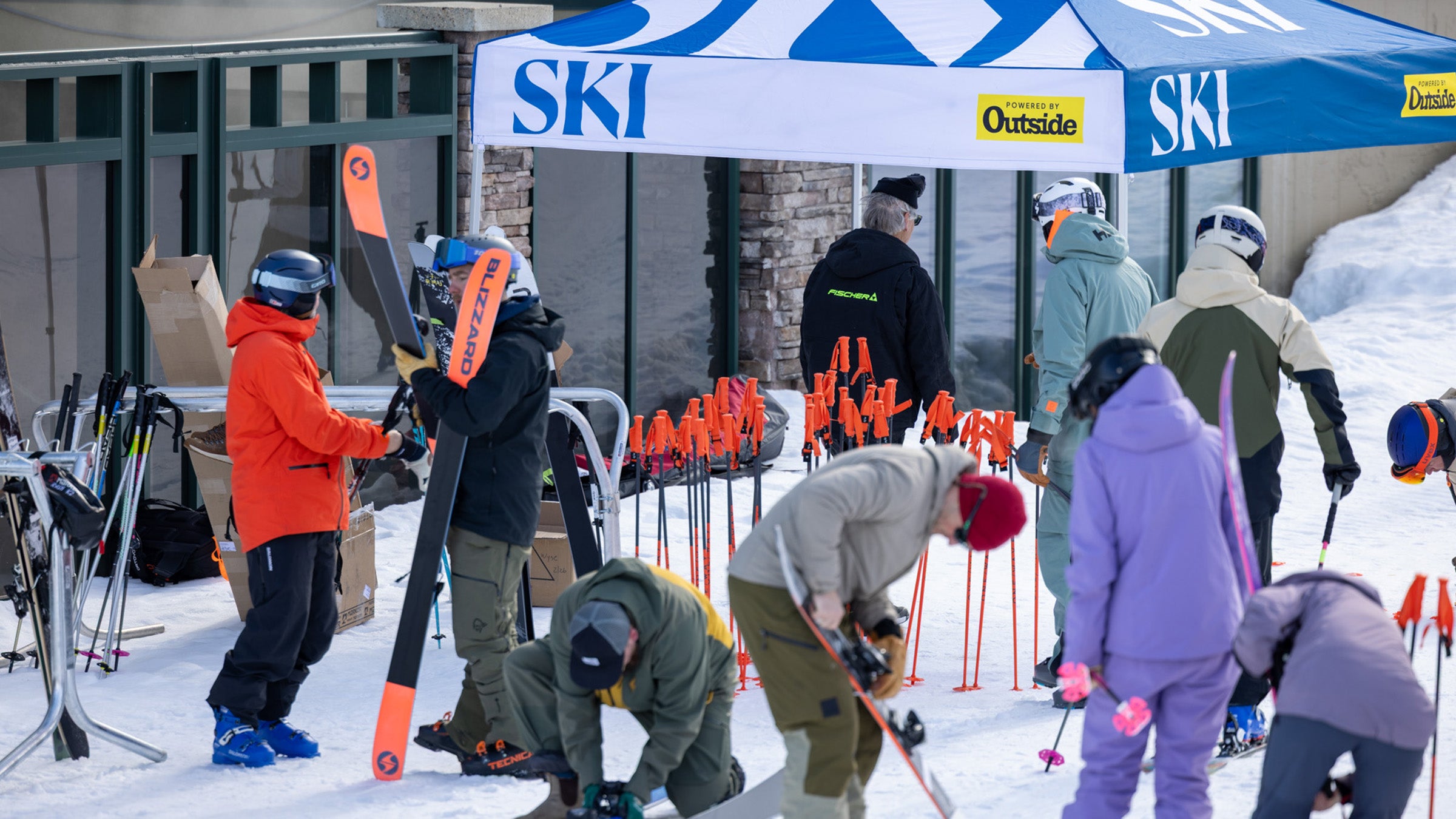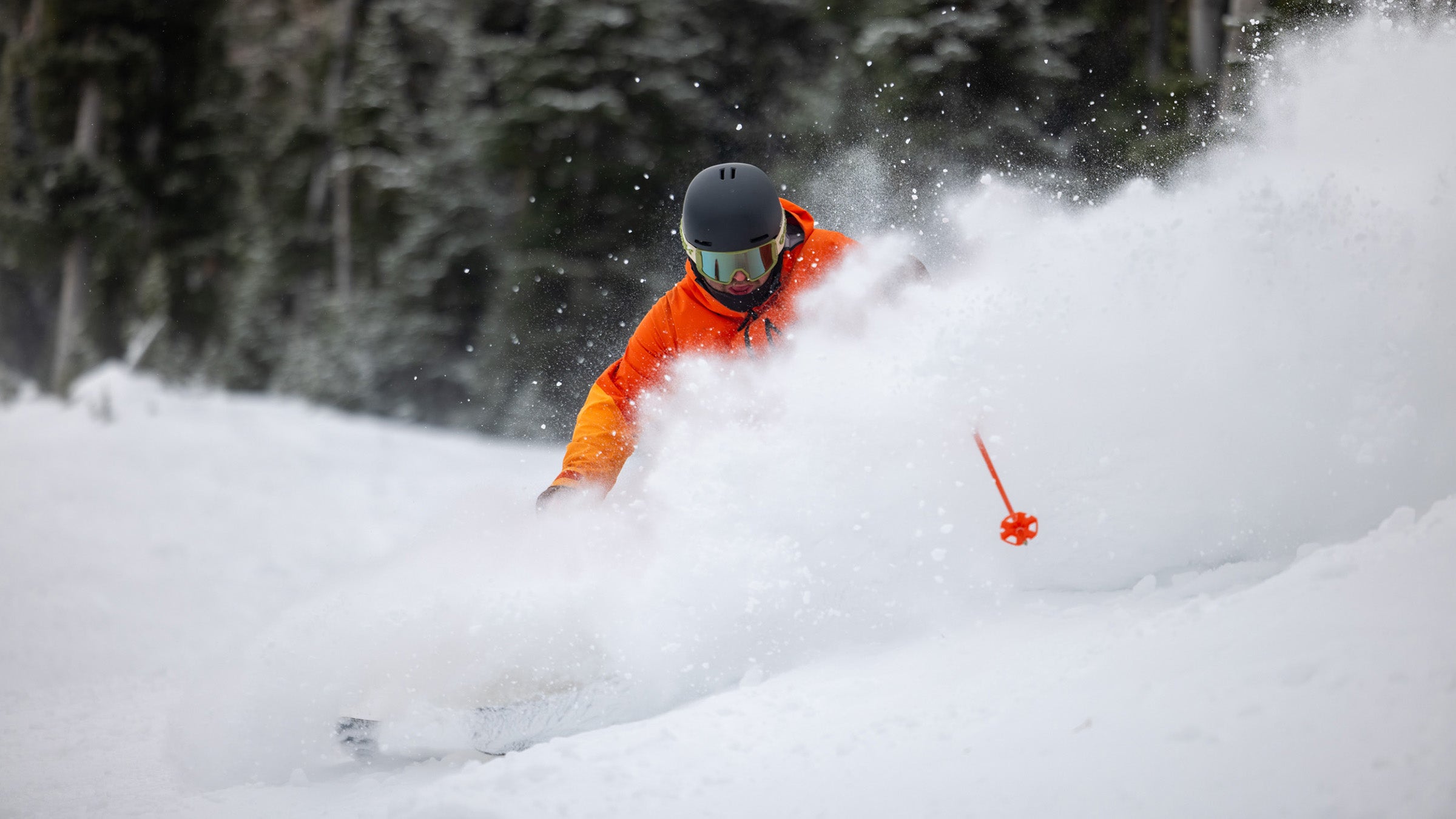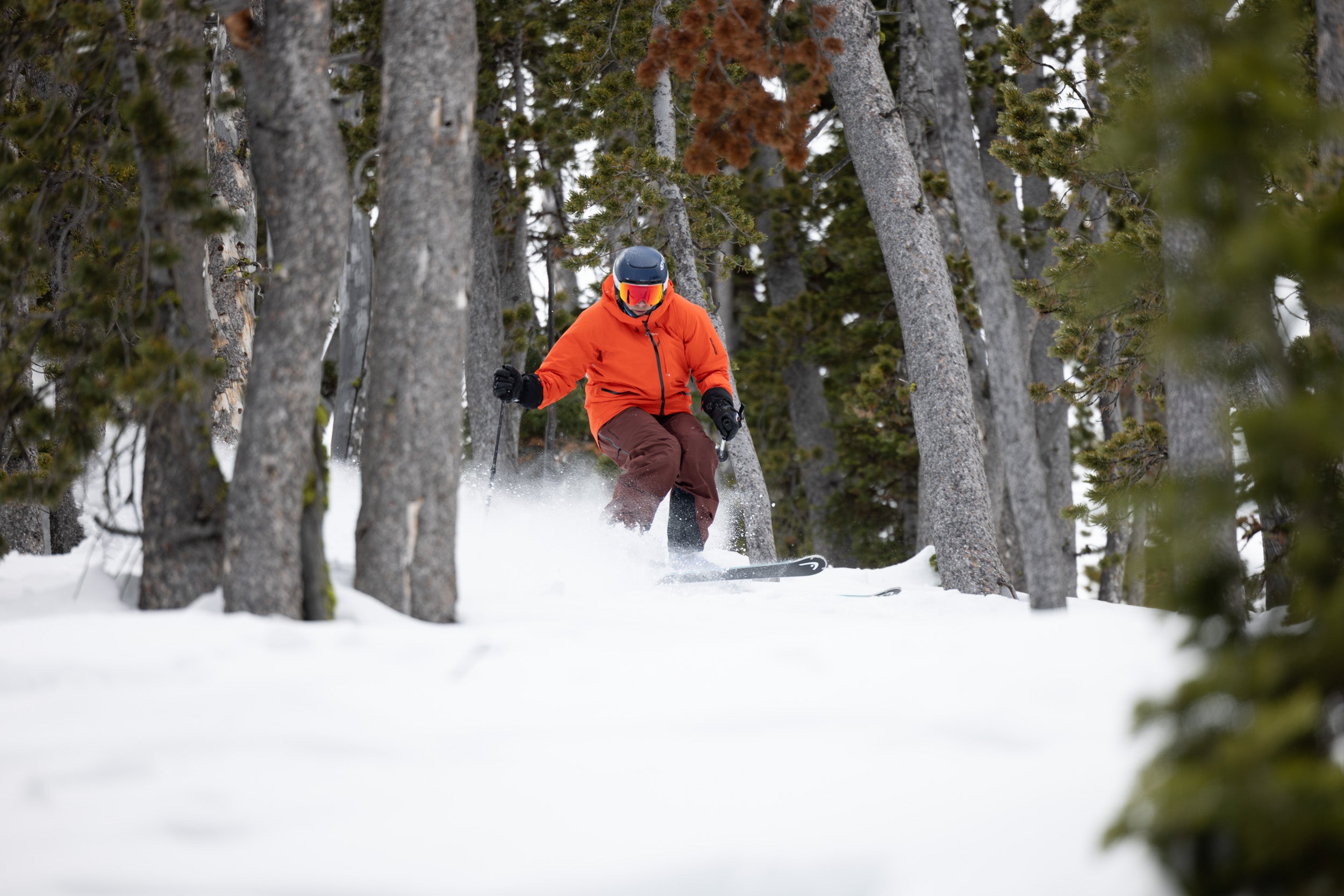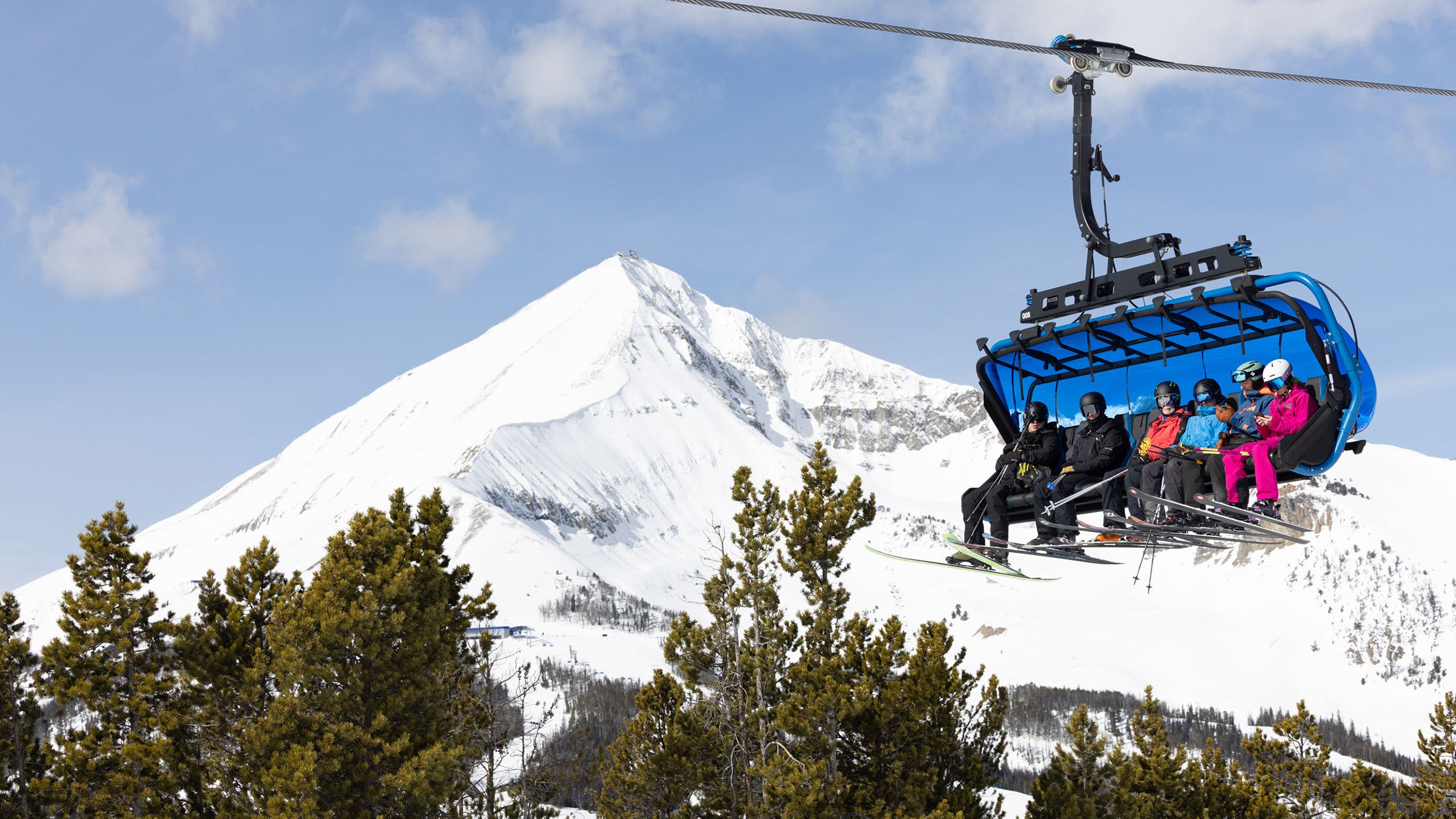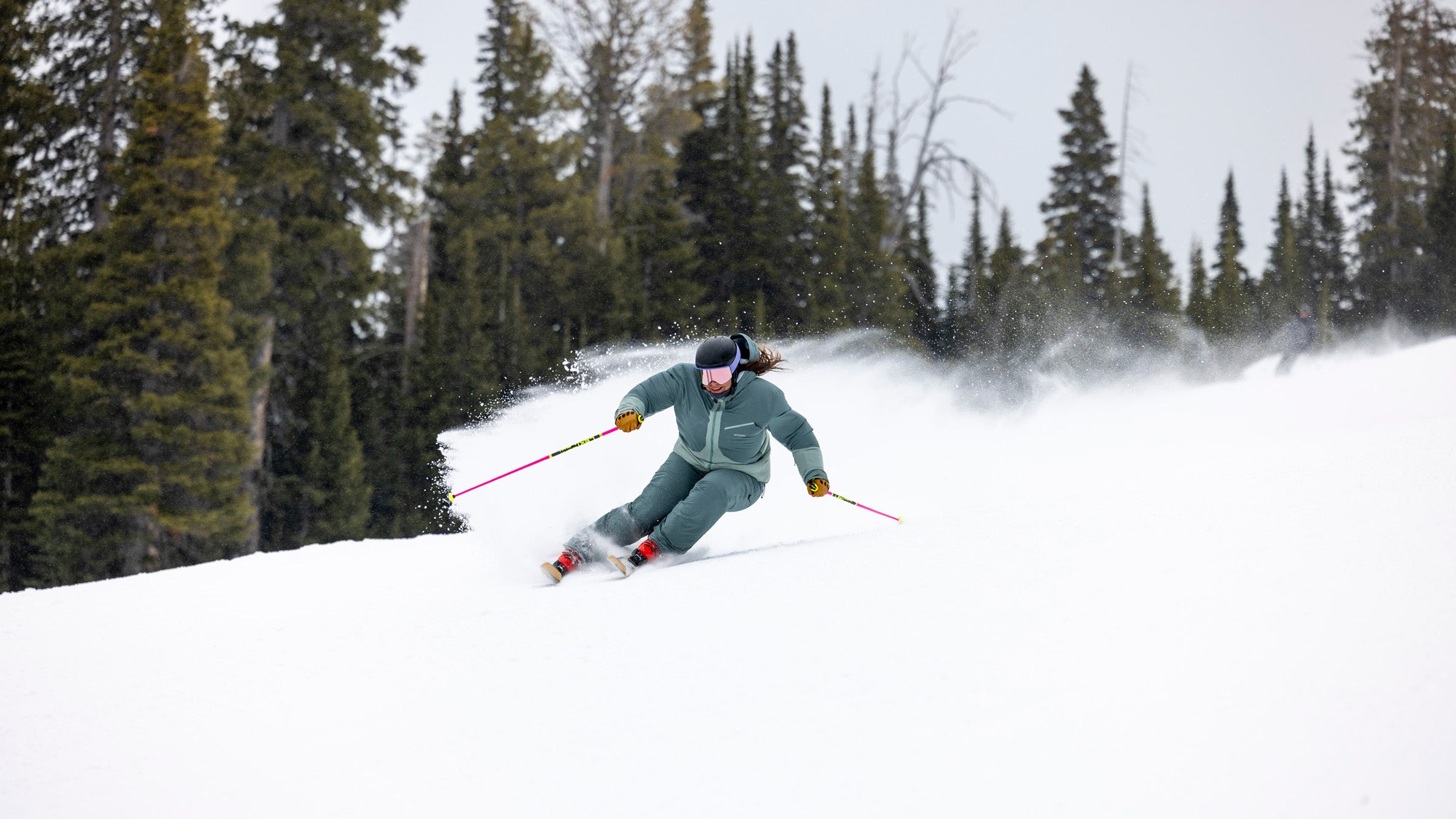If you buy through our links, we may earn an affiliate commission. This supports our mission to get more people active and outside.Learn about Outside Online's affiliate link policy
More Width, More Fun: The 7 Best Wide All-Mountain Skis of 2026
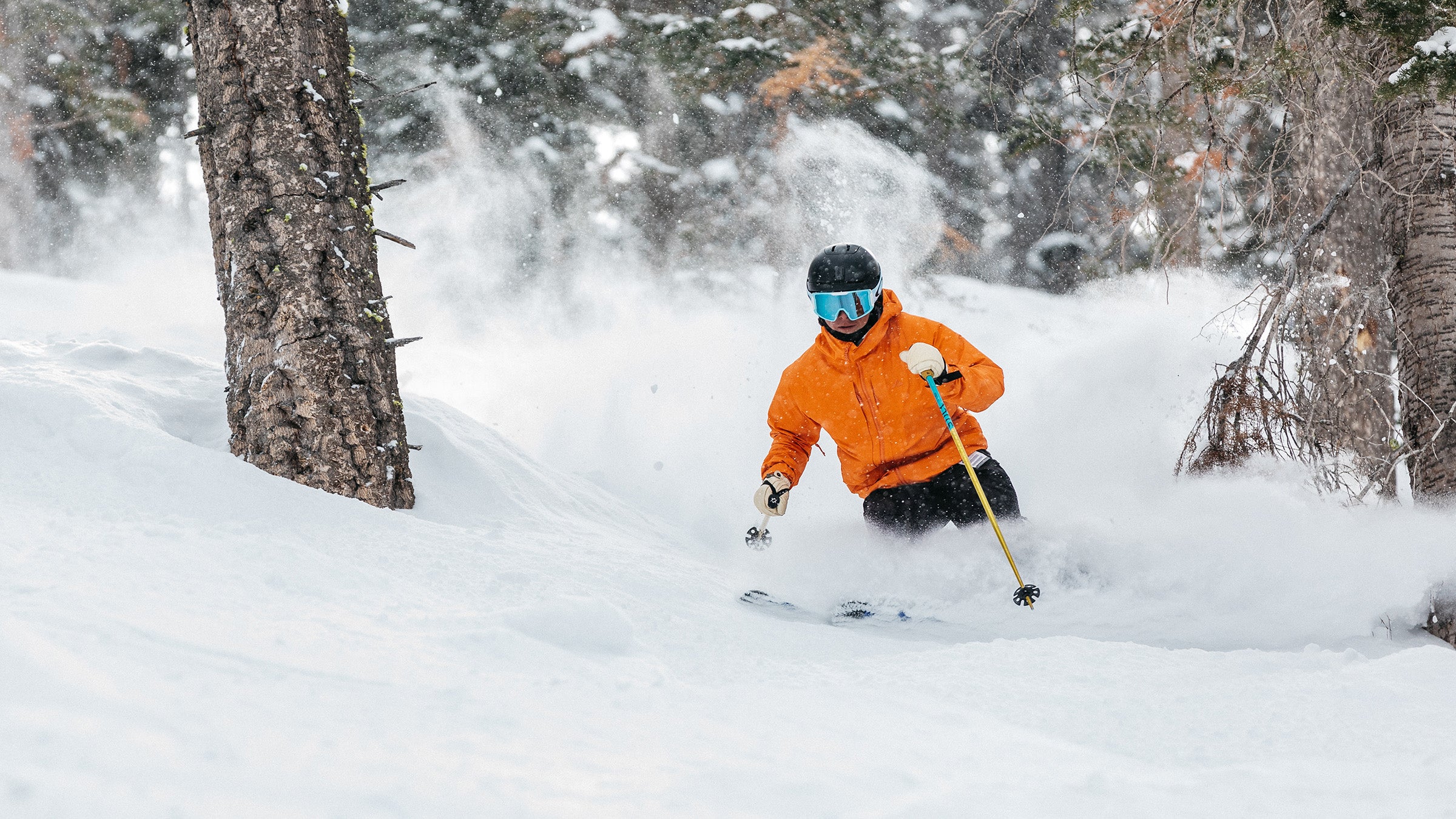
(Photo: Ray J Gadd)
Table of Contents
Not quite powder ski, not quite all-mountain, the wide all-mountain category exists in that sweet in-between. What’s the difference? Basically waist width—and your agenda. With waist widths in the 100 to 110 millimeter range, wide all-mountain skis typically feature less metal and overall heft than traditional all-mountain skis, but a narrower waist and more meat than powder skis.
If you prioritize getting pitted, but inhabit the same reality most of us do—in which you’ll have to ski crud, bumps, chalk, and (gasp!) groomers on the way to untracked snow—a wide all-mountain ski is what you’re after. These skis are wide enough to float through powder, but not so fat and flimsy that they can’t handle the real-world demands of daily resort skiing. We tested 16 wide all-mountain skis in Big Sky, Montana, last spring to find the most versatile, dependable, and fun of the bunch. These are the seven best wide all-mountain skis of 2026.
Best Wide All-Mountain Skis: At a Glance
- Best in Test: Blizzard Rustler 10 ($850)
- Best for Most: Rossignol Sender Soul 102 ($700)
- Best Value: Salomon QST 100 ($700)
- Best for Powder: Nordica Unleashed 108 ($850)
- Best New Model: Head Kore Ti 106 ($849)
- Best for Freeride: Dynastar M-Free 108 ($850)
More Skis We Recommend
- Stöckli Stormrider 105 ($1,539)
- Kästle Paragon 101 ($849)
- Völkl Revolt 101 ($750)
- K2 Mindbender 106C ($800)
- Faction Dancer 3 ($879)
The Reviews: The Best Wide All-Mountain Skis
Of the 16 unisex wide all-mountain skis we tested at our annual SKI Test in Big Sky, Montana, these nine stood out as top performers. They earned the highest marks across nine scoring criteria, with especially strong results in crud performance and flotation—the two performance characteristics we prioritize when reviewing wide all-mountain skis. Read more about our testing process here.

Best in Test: Blizzard Rustler 10
Lengths: 162, 168, 174, 180, 186, 192 cm
Dimensions: 134-102-123 mm
Pros and Cons
⊕ Balanced daily driver
⊕ Lots of size options
⊕ Hesitant to float at slower speeds
⊗ Prefers directional skiing on hardpack
Tina Turner’s 1989 smash hit “The Best” wasn’t about the Blizzard Rustler 10, but it might as well have been. Like that timeless song, the Rustler 10 continues to resonate, and returns unchanged except for a graphics update this season.
“I know people say the unicorn ski doesn’t exist, but this is pretty dang close,” said 24-year-old tester Cooper Johnson. “It’s soft and playful, but also reliable and damp at the same time. No need for a quiver if you own this ski.”
Don’t just take his word for it: The Rustler 10 received top scores in five out of the 10 criteria we test for. While it impressed across the board, it stood out for its steady performance in crud, quickness, playfulness, and responsiveness across the whole mountain. Testers also reported that it could faithfully serve intermediate and experts alike. It’s energetic without being demanding, easy to lay over, and likewise easy to break free from a turn. The latter comes in handy because its 17.5-meter radius lends itself to longer turns.
Credit this ski’s balance of skills to Blizzard’s unique construction technology that pairs a three-piece sheet of Titanal (for edge hold and damping) with a wood core that tunes the flex profile to ski length. That winning combination gives the Rustler 10 a unique balance of playfulness and dependability that can be hard to come by in the wide all-mountain ski category. The only small knock against the 102-millimeter-waisted Rustler 10 is that it doesn’t float like some of the wider all-mountain skis we tested. If a powder ski is what you’re after, look elsewhere; but if you’re in the market for a quiver-killer and gravitate to wider planks, the Rustler 10 is your best bet. Read the full review here.

Best for Most: Rossignol Sender Soul 102
Lengths: 156, 164, 172,180, 188 cm
Dimensions: 135-102-125 mm
Pros and Cons
⊕ Predictable and dependable
⊕ Easy to ski
⊗ Not lively or exciting for aggressive skiers
After making a grand comeback (of sorts) last winter, Rossignol’s Sender Soul 102 returns unchanged for a second season. The progeny of one of the most widely loved all-mountain skis of all time—Rossi’s Soul 7—this reiterated version continues to appeal to a huge swath of skiers.
Light with predictable, easy handling, it carves, floats, and smears on groomers and off-piste with minimal effort. It’s the kind of ski that more or less skis itself, whether an intermediate or an expert is clicked in. “It’s a great all-mountain ski for, like, 75 percent of middle-bell-curve skiers,” said tester Alex Cernichiari.
Others agreed, calling the Sender Soul 102 forgiving, approachable, and dependable. Their only niggles: It’s not the most exciting option for aggressive skiers who like to push their planks and expect some pop and pizazz in return. Generously rockered tips—that are made lighter for easier turn initiation—also limit the ski’s stability at full-throttle. But there is an age-old solution for that: Size up in length, and you’ll get more stability at speed while still reaping the benefits of a more forgiving ride.

Best Value: Salomon QST 100
Lengths: 148, 156, 164, 172, 180, 188 cm
Dimensions: 134-100-122 mm
Pros and Cons
⊕ Lightweight
⊕ Energetic yet stable
⊕ Forgiving
⊗ Not great in powder
⊗ Less dependable in crud
The new QST 100, part of Salomon’s redesigned QST line, feels like a ski honed by years of design tweaks that haven’t completely transformed it so much as slowly perfected it.
With top marks for forgiveness and versatility, it has just the right balance of pep and dampness to feel energetic without being demanding, and enough edge hold to be stable at speed without locking you into a turn—you can shut this ski down in a hurry if you get into trouble. A poplar wood core makes it light (for easy skiing inbounds and even touring out of bounds), while exotic materials like cork and basalt somehow perfectly balance snap and vibration absorption, with a well-honed ratio of camber to tip and tail rocker that results in beautifully precise yet releasable steering.
“Those looking to swivel their way into good turns, and those that make the mountain their playground, should take a look at the QST 100,” said tester Otto Gibbons, who regularly skis Washington’s Crystal Mountain. “It’s easy to use, and entertaining to see where it can take you,”
Heavier skiers may find the 100 millimeter waist a touch narrow if conditions get really deep, and it may not smash through crud or grip hard snow as confidently as some of the heavier, stiffer skis on this list, but the QST 100 offers something those other skis don’t: fun, easy skiing all over the mountain.

Best for Powder: Nordica Unleashed 108
Lengths: 162, 168, 174, 180, 186, 191 cm
Dimensions: 140.5-108-129.5 mm
Pros and Cons
⊕ Oodles of power and flotation
⊕ Smashes crud like the Hulk
⊗ Slow to initiate
⊗ Requires a bit of extra work
A floaty, rewarding charger for advanced skiers, the Nordica Unleashed 108 sits modestly in between the Unleashed 98 and 114 models, and has enough versatility to lean into either groomers or pow, though it really shines in the latter.
With a twin tip shape and generous amount of rocker in the tip and tail, it’s playful in nature and built to float (it outscored all other skis on this list in flotation). But don’t be fooled by its surfy shape—the Unleashed 108 is not an easy-skiing pow ski. A sheet of metal in the layup gives it heft and ensures it still carves and charges remarkably well for a 108-millimeter-waisted ski. “It’s a really strong ski, for a uniquely strong skier,” noted Chad Jacob, a 210-pound tester from Bristol Mountain, New York. “It’s solid and requires a lot of effort, but chargers will appreciate its stability.”
With the Unleashed series, Nordica offers a ride that is a touch lighter than their Enforcer skis, but still caters to those who like to smash down the mountain like bulldozers.

Best New Model: Head Kore 106 Ti
Lengths: 162, 168, 174, 180, 186, 191 cm
Dimensions: 140.5-108-129.5 mm
Pros and Cons
⊕ Smooth as butter
⊕ Very stable
⊗ Doesn’t like short turns
⊗ Prefers open terrain
Winning formulas are hard to mess with, and Head’s Kore series has been a fan fave since it first came out. Still, the Kore family’s big critique in the past has been the jitteriness that results when you make a stiff ski too light. Well, gone are those woes with a freshly added sheet of Titanal that transforms the new Kore 106 Ti into a vibration-gobbling, high-speed machine.
Devotees will find the Kore 106 Ti’s directional shape familiar—with a long, low rocker up front that helps keep the ski above the fray in crud—but thanks to the added heft, the ski now rides much damper and smoother. Imagine if you gave bigger shocks to a sports car, and you’d get the idea of the full suspension feel of the new Kore 106 Ti.
“It’s an out-west all-star,” said tester Luke Larsen, owner of the Lift House ski shop. “It’s not hard to ski and feels comfortable in all but the firmest conditions. It lets you pick the turn shape and doesn’t ask too much.”
While it doesn’t demand an expert driver, the ski prefers arcing large-radius turns down the fall line, so it’s best suited to those comfortable with speed. Testers noted that it really comes alive when actively driven, but agreed that strong intermediates could benefit from this ski’s reassuring dampness and smoothness. It’s not the most playful, energetic, or lively ski on this list, but it’s amazingly balanced and dependable in a variety of conditions and terrain, making it a great one-ski quiver option for skiers who prefer wide all-mountain skis.

Best for Freeride: Dynastar M-Free 108
Lengths: 162, 170, 178, 185, 192
Dimensions: 138-108-128 mm
Pros and Cons
⊕ Balanced
⊕ Dependable in variable conditions
⊗ Not the quickest
⊗ Not overly energetic
Dynastar’s M-Free 108 returns unchanged for 2026, and for good reason. Designed for freeriders, it offers enough waist to float, power to charge, and shape to play. At our test in Big Sky, it earned consistently strong marks across scoring criteria, striking one of the best overall balances—for the right skier.
The M-Free 108 is a heavier ski (2,200g per ski in the 185 cm length), with a long effective edge, more modest tip and tail rocker, and medium stiffness that only returns slight pop out of the turn. For skiers who gravitate toward power over energy, it’s a winning combination. “It’s so versatile, and skis well in both soft and firm snow,” reported tester Jake Stern. “It’s damp, powerful, and still loose enough to slip, jump, and play around on.”
Stern went on to call it the quintessential Mammoth, Jackson, and Snowbird ski, best suited to big, open terrain where it can show off its blend of stability and playfulness. Its only shortcoming is that it’s slower to transition from edge to edge, making short turns a chore. This is the kind of ski that comes alive with a heavy foot mashing on the gas.

Most Accessible: Atomic Maverick 105 CTI
Lengths: 170, 178, 185,191 cm
Dimensions: 134.5-104.5-123.5 mm
Pros and Cons
⊕ Easy yet dependable
⊕ Playful
⊕ Lightweight
⊗ Not great in crud
⊗ Loses stability at high speed
One of the more even-handed skis in our test, Atomic’s Maverick 105 CTI didn’t quite have the same rule-breaking bravado that Tom Cruise made famous in both Top Gun films. Instead, it proved quite composed and disciplined, not wandering off on its own mission, and obeying orders from its commanding officer with impressive fidelity.
Nimble and dependable, this directional ski has enough metal to charge yet enough new-school personality to be playful. A combination of carbon and Titanal in the core precisely hones stiffness while keeping the ski’s weight low. That of course comes with the predictable tradeoff of a bit less power through crud, as well as requiring a firm foot to keep the jitters away at speed—though it’s do-able.
A progressive mount point positions the skier further forward on the ski, making it easier to steer the shovel, while Atomic’s beveled 3D tip also helps with flotation, and buttering—if that’s your thing. “This is maybe the most confidence-inspiring all-mountain ripper I’ve been on in a long time,” said Tommy Flitton, a ski coach from Snowbird, Utah.
In other words, the Maverick 105 CTI is the kind of ski an aspiring intermediate could grow on, or a seasoned expert could relax on.
More Skis We Recommend
The following wide all-mountain skis are models that excel in specific areas like quickness or stability at speed, offering strong alternatives for skiers with specific performance preferences.

Stöckli Stormrider 102
Lengths: 173, 182, 191 cm
Dimensions: 135-102-125 mm
Pros and Cons
⊕ Powerful
⊕ Stable at speed
⊕ Carves like a race ski
⊗ Minimal flotation
⊗ Limited length options
The Stöckli Stormrider 102 was born with a stiff upper lip and zero tolerance for wimps. This Swiss-made ski carries the DNA of a GS race ski (with a price tag to match), prioritizing edge hold and stability above all else. Though it has some off-piste capability, its true calling is speed and it’s a rocket ship on groomers. A perennial favorite among our more technical testers, the Stormrider 102 is a solid choice for those who want to push the throttle and enjoy unmatched precision and power, both on and off the groomers. It stings like a bee, just don’t expect it to float like a butterfly. “This ski is burly and will put hair on your chest,” noted 6’1” tester Cooper Johnson. “If you’re looking to ski fast and hard on a variety of terrain and snow types, this is the ski for you.”

Kästle Paragon 101
Lengths: 169, 176, 182, 190 cm
Dimensions: 135-101-122 mm
Pros and Cons
⊕ Fast and stable
⊕ Plows through anything
⊗ Not great in powder
⊗ Sluggish off-piste
The Paragon 101’s roots run deep in racing, built with the same materials and design principles that give race skis their bite, edge hold, and acceleration. While it sits in the wide all-mountain category with a 101-millimeter waist, it stays true to Kästle’s core characteristics: speed and precision. Though not the most demanding ski in our test, the Paragon 101 clearly prefers hard snow. It’s a finely tuned expert charger that thrives in everyday conditions, offering excellent stability through crud and smooth, and predictable handling on groomers. A touch of tip rocker adds some off-piste versatility, but this ski feels most at home on corduroy. It’s a workhorse of a ski—just be ready to work it.

Völkl Revolt 101
Lengths: 168, 175, 182, 189 cm
Dimensions: 133-101-115 mm
Pros and Cons
⊕ Exceptionally nimble
⊕ Floats well above its waist size
⊗ Pintail is harder to carve
⊗ A little light for crud-busting
Völkl has been growing ever more progressive over the years, and the Revolt 101 is the proof in the pudding. The German ski maker’s newest wide all-mountain model is a narrower version of the playful Völkl Revolt 114 that’s better suited to daily driving at the resort. With a generous rocker profile, a 3D Radius Sidecut, a pintail, and plenty of taper, the new Revolt 101 is a freerider’s buffet: It floats like it’s much fatter, pivots and slashes at will, and is also light enough (2,200 g in the 182 cm length) to take touring. While it’s built for off-piste terrain, if commuting on groomers is unavoidable, the Revolt 101 can still carve reasonably well—if you put some muscle into it.

K2 Mindbender 106C
Lengths: 169, 176, 183, 189 cm
Dimensions: 138-106-127 mm
Pros and Cons
⊕ Easy to ski
⊕ Goes anywhere
⊗ Not dependable in crud
⊗ Chatters at high speed
K2’s Mindbender 106C is a freeride ski that’s light on both the planet and the snow, thanks to a construction that uses flax and bio resins. It has a mostly directional feel, with modest tip and tail rocker and traditional camber underfoot for stability and edge hold. At our Big Sky test, the Mindbender 106C earned high marks for responsiveness and forgiveness. Testers called it the ski equivalent of dad rock: easy listening, easy skiing. The tradeoff for a light construction that makes it especially easy to ski is a lack of dependability in crud and at speed. But if cruising around the mountain is your MO, this is a good pick. “It’s a fun, accessible platform for exploring the entire mountain in any condition,” said tester Otto Gibbons, a hardgoods buyer for Cristy Sports. “It’s great for skiers who aren’t driving into every turn or skiing angry. Skiing is supposed to be fun, after all.”

Faction Dancer 3
Lengths: 164, 172, 178, 183, 188 cm
Dimensions: 134-106-124 mm
Pros and Cons
⊕ Strong and dependable
⊕ Floaty
⊕ Smashes through crud
⊗ Long turn radius
⊗ A tad demanding
Now here’s a ski you can take to the prom. For those that want a lightweight partner that’s also strong and stable and can catch you no matter how clumsy you are, get in line to ask out the Dancer 3. “If you’re trying to get after it and charge hard, this is a really fun, damp ski that crushes,” said Snowbird ski coach Tommy Flitton. And while some testers found the Dancer 3’s somewhat stiff and snappy flex profile a bit demanding, most found it could cruise from pow, to chalky steeps, to groomers with impressive, consistent energy and—though minimal—just enough dampness. Tester RJ Peshek, whose moves are famous all over Aspen, added, “The Dancer 3 is a really fun, hard-charging ski that has no speed limit and comes with a proper back bone.”
Best Wide All-Mountain Skis Comparison

About SKI Test
- Skis tested: 16
- Testers: 30 expert skiers from the ski industry
- Location: Big Sky, Montana
- Tester range: Ages 21–57 | Heights: 5’4”–6’3” | Weights: 125–250 lbs
Each year, SKI’s editorial team conducts one of the most rigorous and trusted ski tests in the industry. At the 2025 SKI Test in Big Sky, Montana, 30 experienced skiers from across the country tested 16 wide all-mountain skis in real-world resort conditions. To reduce subjectivity, all testers skied each model on the same day, in the same conditions, and submitted digital scorecards evaluating each ski across nine criteria:
- Versatility
- Flotation
- Hard-Snow Integrity
- Stability at Speed
- Responsiveness
- Crud Performance
- Quickness
- Forgiveness
- Playfulness
When judging the wide all-mountain skis, we place the greatest emphasis on crud performance and flotation—two key indicators of a top-tier wide all-mountain ski. The nine winners on this list earned consistently high marks across all categories, especially those three. The skis included in the “More Skis We Recommend” section are models that excel in specific areas like playfulness or forgiveness, offering strong alternatives for skiers with specific performance preferences. Learn more about our testing methodology and scoring criteria here.
Why You Can Trust Our Reviews
Our ski reviews are the result of the largest, most rigorous on-snow test in the industry. We never charge brands to participate and don’t guarantee coverage—our annual SKI Test is a fully independent editorial project designed to deliver objective, in-depth reviews. Our 30 expert testers include ski instructors, ski patrollers, ski shop owners, hardgoods buyers, ski technicians, and race and freeride coaches. We handpick this crew for their professional expertise and intentionally include a range of body types, ages, and home mountains to reflect the broader ski community. Bottom line: There’s no pay-to-play here—just honest feedback from people who know skis. Meet some of our veteran testers below:
Chad Jakob
Age: 43 | Height: 5’10″ | Weight: 210 lbs
Jacob is a ski race coach from the East Coast—and he skis like one. At his home hill of Bristol Mountain, N.Y., you’ll likely find him carving up icy groomers on a set of skinny skis. Jacob is a veteran gear tester who has tested skis for both Outside and SKI.
Cooper Johnson
Age: 24 | Height: 6’ | Weight: 170 lbs
Johnson was born and bred in Aspen, Colorado. By day, he’s a ski technician at Aspen’s Hamilton Sports; by night, he’s sewing together fleece patterns for his apparel brand, Outpst. When he’s not in the shop or working at his sewing machine, you’ll find him tearing up Aspen Snowmass. He joined SKI’s test squad in 2024.
Tommy Flitton
Age: 32 | Height: 5’10” | Weight: 185 lbs
Flitton is a freeride coach at Snowbird, Utah. When the snow melts, he heads north to spend his summers as a fly fishing guide in Montana.
Frequently Asked Questions
What are wide all-mountain skis?
Wide all-mountain skis are slightly wider than typical all-mountain skis, with waist widths that hover between 100 to 110 millimeters. While they’re still versatile all-mountain skis, they cater more to soft snow and powder and less to skiing groomers than narrower all-mountain skis.
What’s the best wide all-mountain ski for experts?
SKI’s expert testers named the Blizzard Ruster 10 the best wide all-mountain ski for experts. It’s powerful and dependable in variable conditions yet also playful in soft snow. Read more here.
What’s the best wide all-mountain ski for powder?
The Nordica Unleashed 108 outperformed all the other all-mountain skis we tested in powder. With a wider waist (108 mm) and plenty of tip and tail rocker, the Unleashed 108 is made to float through the fluff.
What’s the best width for all-mountain skis?
All-mountain skis come in a variety of waist widths ranging from 80 millimeters on the narrow side to 110 millimeters on the wider side. The best waist width for you depends on what type of skiing you do and what performance characteristics you prefer in a ski.
If you primarily ski off-piste in crud or on slopes with more than six inches of powder, you’ll want a wide-waisted all-mountain ski (around 100 to 110 millimeters). That will give you a wider and sturdier platform underfoot. If you live somewhere that doesn’t see a ton of snowfall, or if you primarily keep to groomed terrain with the occasional venture off-piste, a ski with a 80- to 95-millimeter waist will offer better performance on hard snow and ice, in moguls, and on edge on groomed terrain.
Do I need a wide all-mountain ski?
Wide all-mountain skis are better suited to skiers who primarily ski off-piste at resorts that see abundant snowfall. Wide all-mountain wide skis generally handle powder and crud better than all-mountain narrow skis. However, wider skis do sacrifice some edge performance, so skiers who care about making precise turns and carving on groomers occasionally should look to narrower all-mountain skis.
What’s the difference between men’s and women’s skis?
In truth, most skis are unisex and not gender-specific. Many brands produce the ski with the exact same construction technologies for both genders, but often create two different top sheets to appeal to men vs. women. A handful of brands are making truly women’s-specific skis, where the ski takes a woman’s physique into account when building the ski. Men and women can ski on the same ski but may want to choose different lengths depending on their height and their skiing ability.
More from the 2026 Winter Gear Guide
The Best All-Mountain Skis
The Best Frontside Skis
The Best Carving Skis
